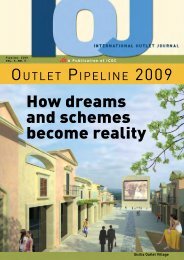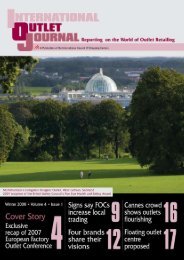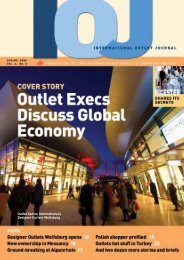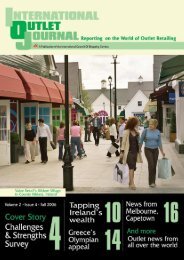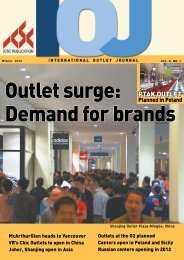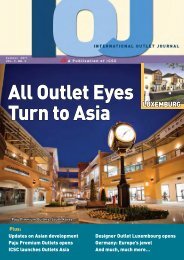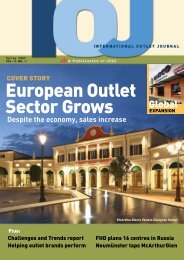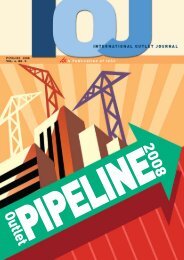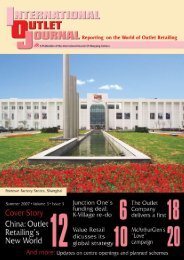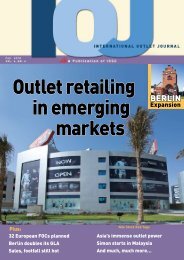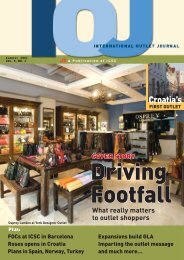percassi's conquest: Sicilia Fashion Village - Value Retail News
percassi's conquest: Sicilia Fashion Village - Value Retail News
percassi's conquest: Sicilia Fashion Village - Value Retail News
You also want an ePaper? Increase the reach of your titles
YUMPU automatically turns print PDFs into web optimized ePapers that Google loves.
ReCon asia draws<br />
an outlet crowd<br />
Outlets were the focus of<br />
attention at the ICSC’s 2010<br />
RECon Asia, held November 7-9<br />
at the Beijing International Hotel and<br />
Convention Center.<br />
By all accounts, “Outlets: Where Are<br />
They Going in Asia?” was the most<br />
widely attended of the educational sessions<br />
held at the three-day conference,<br />
drawing an audience estimated at more<br />
than 300 attendees.<br />
Panelists of the 45-minute session<br />
were John R. Klein, CEO, Premium<br />
Outlets/Simon Property Group; Mark<br />
Silvestri, SVP, Premium Outlets/<br />
Simon Property Group; Richard Li,<br />
EVP, Globe Outlet City Holdings;<br />
John Chung, EVP, Globe Outlet City<br />
Holdings; and Kan Chang, EVP, Urban<br />
<strong>Retail</strong> Properties – Asia. Moderator was<br />
Peter B. Leckerling, Managing Director,<br />
Leto Commercial Consulting.<br />
Leckerling,<br />
whose firm brings<br />
international retail<br />
brands and real<br />
estate developers<br />
into the China<br />
market, opened up<br />
the discussion by<br />
outlining general<br />
outlet trends<br />
leckerling<br />
in Asia before going into more depth<br />
regarding the China market, where he<br />
sees enormous potential. Leckerling said<br />
projects opening recently in China have<br />
largely underperformed, but he explained<br />
that the learning curve for Chinese firms<br />
taking on outlet projects has been very<br />
steep.<br />
He added that outlet sites he had<br />
recently visited demonstrated a better<br />
understanding of the fundamentals<br />
necessary for successful outlet development.<br />
Furthermore, the quality and<br />
success of the projects will continue to<br />
improve as Chinese developers come to<br />
the realization that outlet centers require<br />
long-term ownership and high levels of<br />
investment in ongoing management and<br />
maintenance.<br />
Klein and Silvestri, the only panelists<br />
that have actually opened outlet<br />
centers in Asia, brought much-sought<br />
experience and insight to the discussion,<br />
particularly on some of the key<br />
factors for driving footfall. Simon has<br />
opened eight outlet centers in Japan (in<br />
Gotemba, Ibaraki, Kobe-Osaba, Rinku,<br />
Sano, Sendal, Toki and Tosu) and one in<br />
Seoul, South Korea.<br />
Simon is developing two more<br />
projects in South Korea (in Busan and<br />
Paju) and one in Johor, Malaysia. The<br />
ground-breaking in Malaysia was so<br />
highly anticipated that it dominated<br />
news there for days.<br />
Globe and Urban presented three<br />
new outlet projects that are in development<br />
in Mainland China.<br />
Globe’s projects seek to open up two<br />
of China’s so-called second-tier cities,<br />
Qingdao and Changsha, while Urban’s<br />
first foray into Chinese outlet development<br />
is in the more established market<br />
of Shanghai. All three projects fall into<br />
the mixed-use category, with Globe’s<br />
projects being part of large master<br />
plans that include residential buildings,<br />
convention centers and hotels.<br />
Urban <strong>Retail</strong>’s project (in partnership<br />
RECON ASIA<br />
with Shangtex, China’s largest textile<br />
and garment manufacturer) combines<br />
an outlet center with a large-scale fashion<br />
facility meant to launch Shanghai as<br />
a bona fide fashion capital in Asia.<br />
Urban’s Chang discussed one of<br />
the more controversial aspects of the<br />
Shanghai <strong>Fashion</strong> Center project – its<br />
proximity to downtown. Chang admits<br />
that some brands have expressed<br />
concern about retail sensitivity to their<br />
nearby wholesale accounts. He said,<br />
though, the Chinese are less likely to<br />
leave cities to go on shopping ventures,<br />
so outlet centers can operate successfully<br />
in urban areas.<br />
Conference attendees later said they<br />
were encouraged to learn that major<br />
American and European outlet developers<br />
are actively searching for sites and<br />
partners in the China market. Cities<br />
under consideration include second-tier<br />
markets like Tianjin, Nanjing, Wuhan,<br />
Dalian and Chongqing, where a lack<br />
of quality projects to serve increasingly<br />
strong consumer populations have<br />
created a real opportunity for outlet<br />
developers.<br />
Shanghai and Beijing already have<br />
three strong outlet centers, and a<br />
planned outlet project near the Disneyland<br />
Shanghai (scheduled to open<br />
by 2014 in Shanghai’s Pudong District)<br />
was of interest to brands attending the<br />
conference.<br />
Also heard at RECon Asia: a local<br />
Chinese developer has decided to go<br />
head-to-head with Bailian’s Shanghai<br />
Outlets, opening a competing outlet<br />
center across the street from Shanghai’s<br />
most successful outlet center – in<br />
a slightly more convenient location in<br />
terms of access from the highway. In a<br />
land of no radius clauses, the battle for<br />
dominance should be interesting. c<br />
Information for this recap was<br />
supplied to IOJ by moderator Peter<br />
Leckerling and panelist John Klein.<br />
WINTER 2011 InteRnatIonal outlet JouRnal 13





